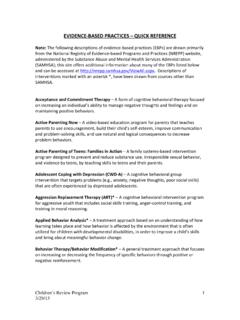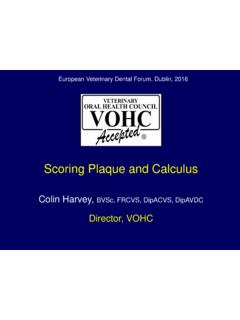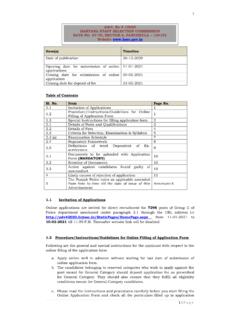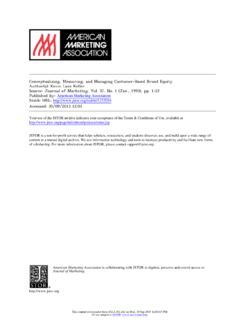Transcription of Guidelines for Waterproofing of Underground Structures
1 Guidelines for Waterproofing of Underground Structures By Parsons Brinckerhoff December, 2008 i 5/8/2009 Guidelines for Waterproofing Underground Structures Table of Contents: Introduction 1 Waterproofing : A System Approach 1 Waterproofing Systems 2 Liquid Systems 3 Panel Systems 4 Sheet membrane Systems.
2 Rubber, Neoprene, Rubber/HDPE 5 Sheet Membrane Systems: HDPE, PVC 6 Epoxy Liner systems 8 Sprayed Coating Systems: Cold Applied 9 Sprayed Coating Systems: Polyurea 10 Cementitious Coating Systems 11 Hybrid Systems: Poly Rubber Gels 13 Hybrid Systems: Waterproof Concrete 14 Cast-in-Place Concrete Diaphragm Walls 16 Waterstops for Penetrations and Joints 17 Vinyl or PVC Waterstops 18 Swelling Rubber Waterstops
3 19 Injection Waterstops 22 Costs 24 Membrane Costs 24 ii 5/8/2009 Waterstops 26 Conclusions and Recommendations 26 Leakage Mitigation 30 Introduction 30 Structure Construction
4 30 Identification of Leaks 31 Leak Mitigation 32 Grouts 32 Grout Selection 34 Costs 36 Conclusions and Recommendations 38 Appendix A Technical Specifications Appendix B Typical Drawings
5 1 of 39 5/8/2009 Introduction The purpose of this document is to discuss Waterproofing options for the construction of Underground Structures , and to provide guidance to the designer for the selection of the proper Waterproofing system for the particular type of structure to be built. The objective is to describe the benefits and deficiencies of each type of Waterproofing system and to assist the designer in the selection of a Waterproofing system that best suits the project conditions. It is important to remember that not one system is appropriate for all projects and this guideline identifies the Waterproofing systems available at the time of writing and reflects PB s experience in the success or failure of each system.
6 Due to the soil and groundwater conditions it is critical that the structure be protected from groundwater infiltration and a suitable site specific Waterproofing system be selected for the structure. The protection of an Underground structure can be performed using a positive side (exterior) or negative (interior) Waterproofing system. In general, the preferred system is a positive side Waterproofing system that protects the structure from all types of attack while providing a tight waterproof membrane. Negative systems are typically used in rehabilitation systems where the exterior of the structure is not accessible.
7 This document will address the various types of Waterproofing systems including advantages and disadvantages of each system. In addition this document will discuss waterstops for penetrations and joints as well as remedial actions to be taken to control groundwater infiltration in the event that the Waterproofing membrane has failed and is causing leakage into the structure. Although this guideline is considered comprehensive it is possible that over time additional Waterproofing systems will be developed and their effectiveness should be evaluated prior to the incorporation into PB documents. Waterproofing : A System Approach In order to understand the applications of Waterproofing it is necessary to have knowledge of the principles of Waterproofing below ground Structures .
8 It is important to understand the difference between Waterproofing which is a coating or membrane that prevents the free passage of all water through a medium, while water-resistant prevents the limited passage of water vapor or water through a medium by the use of a membrane, coating or physical properties. For the purpose of this discussion we will focus on waterproof systems, with limited discussion on water resistant systems The success or failure of a Waterproofing system is often dependent on the owner s expectations for water tightness. Over the years tunnel designers have developed criteria for water tightness which is known as permissible (allowable) leakage.
9 Permissible leakage is the amount of water that is acceptable to the owner for the safe operation of the tunnel. Permissible leakage is often identified as liters/day per square area of lining or as a point source leak in liters/day. These criteria should be established with the client, prior to the bidding to provide acceptance criteria for the Waterproofing . 2 of 39 5/8/2009 Once the criteria are selected for the permissible leakage attention must be drawn to the Waterproofing selection criteria. The following are items necessary for the selection of a satisfactory Waterproofing system: Type of structure Type of construction (bored, cut-and cover, etc.)
10 Depth of burial of structure (lowest elevation of structure) Maximum Elevation of groundwater (after construction) Environmental conditions at the site (including Ph, hydrocarbons, and chemicals) Ease of installation Track record ( successes and failures of the system) Construction Cost Long term maintenance (including costs) In addition to the above a successful Waterproofing system is dependent on the following: Site specific design for this type of structure and conditions Knowledgeable Designer familiar with this type of Waterproofing and structure Proper Specifications and details Educated Owner Proper installation by experienced workmen Full time inspection during construction Warrantee Good track record Waterproofing Systems There are numerous Waterproofing systems available in the market place: Liquid systems toweled or mopped Panel systems Sheet membranes Epoxy systems Sprayed systems Hybrid systems It should b






